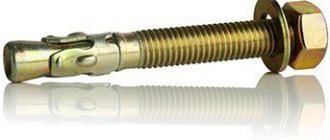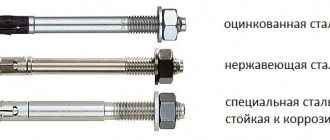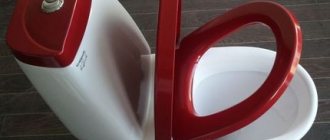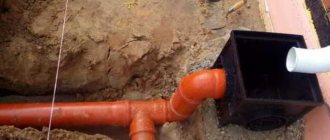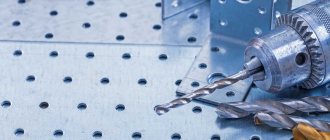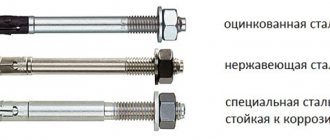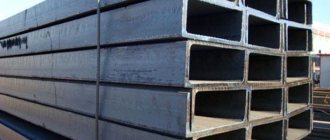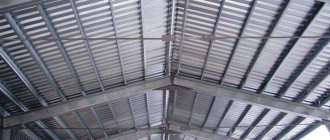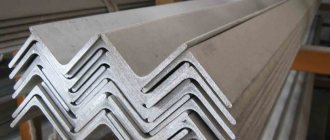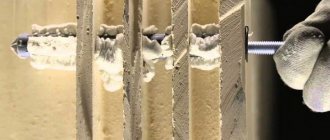Currently, all types of anchor bolts are considered quite common fasteners. Every construction site cannot do without these devices. In this regard, many types of anchors have been created. However, the leading position, as the most used, is occupied by the wedge anchor.
It is the most durable and creates a reliable fastening, supporting any weight. Most often it is used to attach something to concrete, stone, block and brick foundations. There is also an expansion wedge anchor, which is used a little differently.
Where is a wedge anchor needed?
Not many people understand how to choose the right wedge anchor. This often leads to unreliable fastening. In this material we will talk about why a wedge anchor is needed and how to choose it correctly.
In order to create a reliable fastening using a wedge anchor with a nut, a hole must be drilled in the material in advance.
The anchor itself is driven into this hole, and its “petals” wedge, thereby creating the most durable connection. But the installation of the mount does not end there. After the anchor is driven into the hole, its bolt is tightened using a special wrench.
Due to the fact that this fastening option is the most durable for heavy loads, it is the most popular fastener in construction. This is especially noticeable when working with materials such as gas and foam blocks, brick, concrete.
Think for yourself, this mount is not so difficult to install, but at the same time its efficiency is high. And the price of a wedge anchor is not high, and the price difference depends only on the size of the chosen anchor.
It is also worth noting that this type of fastener is applicable not only to concrete structures. A wedge anchor is also useful when installing various metal parts.
This is a huge advantage for DIYers. After all, as mentioned earlier, this fastener is very easy to use and even a beginner can handle it. A wedge anchor is suitable for structures with a large mass, but it must be selected precisely according to all parameters.
Dimensions and principle of operation of the wedge anchor
A wedge anchor consists of a bolt with a sleeve at the end. Installing this mount does not present any difficulties other than drilling the hole. The fact is that the size of the drill for the hole must fully correspond to the diameter of the anchor.
Once the hole is ready, all that remains is to do the simplest part. First, the wedge anchor itself is inserted into the hole. Next, it is hammered in, with instructions for driving in for each anchor.
Finally, the anchor is screwed into the hole using a wrench. This is also done using the recommendations from the instructions. Most often, a galvanized wedge anchor is used to protect it from moisture.
When choosing a wedge anchor, you need to understand that its size depends on many factors. The most important thing is to accurately calculate the load on the fastener. A specialist, store consultant or calculation formula can help with this.
If you have approximately determined all the necessary indicators, but are not entirely sure, then it is better to purchase an anchor of a slightly larger size. This will protect the mount from being overweight. For example, if you calculate that a 10 wedge anchor is suitable for you, then it is better to give preference to 12.
Typically the size and weight of the wedge anchor is indicated on the sleeve. However, there are times when it is missing. Then you can simply measure it using a caliper.
When taking measurements yourself, it is important to determine three values. The first is the diameter of the anchor itself with the sleeve; it will help when choosing a drill.
The second indicator is the diameter of the bolt without sleeve. This indicator is needed to determine the size of the wrench.
And the third indicator is the length of the anchor. To select it correctly, you need to know exactly the thickness of the surface. On the anchor, the parameters are indicated exactly in the sequence in which they are described here.
What you should know:
- If you prefer a fastening such as a wedge anchor, then be sure to read its technical characteristics.
- Remember that installing an anchor is only permitted if the load on it is at least 1/4 of the maximum possible.
- And even if it seems to you that you can easily cope with installing fasteners such as a wedge anchor, use the instructions and study the technology in as much detail as possible.
Source: https://stroimaterials.ru/klinovoj-anker/
What are they?
Wedge anchors are available in different sizes; they are indicated by markings. For example, the parameters of a bolt for concrete 15x12x100 mean the following:
- 15 – body diameter; accordingly, the drill must be chosen of the same size;
- 12 - the size of the stud itself, according to the size of which the nut is selected;
- 100 is the size of the anchor itself; it is selected depending on the thickness of the wall.
The most popular anchors are those whose body diameter and fastener length are: 6x40, 10x100, 12x100, 6x60, 8x80, 12x120, 10x120, M12, as well as 10x95 and 12x150. Fasteners of various lengths are fixed to the optimal depth. Thus, reinforced fasteners, the length of which is 40 mm, must be mounted in a hole with a depth of 25 mm or more. It is very important to understand that the length of the hardware should depend on the thickness of the module that will be fastened with this fastener.
In accordance with current GOSTs, the shortest length of a wedge anchor is 40 mm, the remaining parts increase in increments of 5 mm. The maximum size is 100 mm; longer products are extremely rare.
The anchors presented for sale have different characteristics of the maximum permissible mechanical load and the highest leveling load. However, both of these indicators are directly dependent on each other: the first parameter for anchors can exceed the second by no more than 1/4. When choosing a product, you should take into account the maximum permitted load. The concrete base, due to its technical and operational characteristics, is very strong and dense, so it requires the most reinforced anchor.
Wedge anchor - how to install
In construction, reliable fasteners are needed to connect large and heavy structures. Wedge anchors are used for installation of such structures. In appearance, the fastener resembles a hairpin, the working part of which is cone-shaped.
There is a spacer sleeve on the cone. Another name is a hairpin anchor. A threaded element is also required to securely fix the fastener. The materials used are carbon steel and stainless steel, providing high wear resistance.
When to use a wedge anchor
If construction work has begun, no matter what the volume, a wedge anchor can be of great help. Of course, such fasteners will be needed in large quantities only during capital construction, but even “cosmetics” involves replacing any household appliances, the installation of which will not be complete without a thorough connection.
For example, when installing air conditioners, boilers, satellite dishes, anchors of different sizes are used. To which surface is it attached?
- concrete
- brick
- natural stone
That is, it can be a wall, a ceiling, or a floor. In capital construction, fasteners are used to connect:
- beams,
- metal structures,
- channels,
- fencing,
- awnings
But when choosing a suitable option from a wide range of wedge anchors, it is worth taking into account the technical characteristics, which are determined by the markings on each part and correspond to GOST.
Types of wedge anchors
The technical characteristics of the wedge anchor depend on the manufacturer, which indicates the parameters of the part necessary for proper operation. What to consider when labeling:
- thread diameter
- usable length
- maximum length (not always given)
There are also combinations of letters and numbers, which makes it possible to determine what the main parts and sizes of components are equipped with. Often, in front of the markings there are abbreviations of the companies that produce these products.
Example. The s-ka wedge anchor is marked as follows: S-KA 8x50. This means that the part was made in Finland from steel. The diameter of the anchor itself and the thread is 8 mm, and the total length of the product is 50 mm. If D is added, this indicates the presence of an additional component (two spacers).
Russian GOSTs indicate strength indicators, as well as materials of manufacture. They are deciphered using special tables, which are now published on the Internet.
Other anchor characteristics
In order to purchase the necessary fasteners, it is worth considering both the parameters of the product itself and the ability to withstand the load of the base surface.
If you approach this issue thoroughly (this is mainly done by design bureaus), then the calculations are based on the methods of leading European manufacturers of similar products. This is resorted to during capital construction, especially multi-storey projects.
Basically, the wedge anchor is chosen, as they say, “by eye.” True, manufacturers often indicate the permissible load of the part on the packaging boxes. The longer it is, the stronger it is.
Also, for heavy structures, the strongest hardware is chosen, which is ensured by the material of manufacture. Galvanized steel is time-tested and especially durable.
Although some manufacturers use other types of steel with a claimed high degree of resistance. Another indicator that is responsible for the long service life of the finished clutch is corrosion resistance.
To increase this parameter, structural steel is galvanized using various additives such as chromium. But if the structure is constantly exposed to aggression from the outside, for example, salty sea water, then galvanizing will not protect against corrosion, which means you need to use hardware made of corrosion-resistant steel.
How a wedge anchor works: installation tips
When choosing a suitable wedge anchor, we give advice with ironclad logic. High strength means a high price, and the lower the price, the lower the strength. Therefore, if you are going to install expensive equipment, then you should not save.
Principle of operation. We first prepare a hole in diameter, oriented along the diameter of the anchor, insert a wedge and tighten the nut. At this moment, the bushing expands and, due to friction against the surface of the hole, is fixed.
Tips to help you complete a successful installation (withstand the load):
- Be sure to capture sufficient torque to tighten the nut to provide the necessary friction force.
- The diameter of the hole should be as close as possible to the diameter of the fastener. For example, if a 12x120 wedge anchor is in use, then the diameter of the entrance to the base (for example, concrete) should be the same, 12 mm. And the length of the hole corresponds to the maximum length of the part (120 mm). This will help avoid a situation where the anchor “crawls out” of the concrete.
- Make sure that the base material is strong enough, because it carries additional load.
- To prevent cracking of the base material, it is necessary to follow the instructions for positioning the anchor to the edge of the base material (wall corner, slab edge, etc.). Also, in the case of using several hardware simultaneously, the distance between them is taken into account. If it is less than permissible, then the internal part of the fastener will simply “rip out” the concrete.
Areas of use
The use of a wedge bolt is widespread in capital construction, as well as in some household repair work. Hardware of this type is indispensable for fixing large structures on walls, floors, ceilings and other surfaces made of particularly strong materials. It is known that high-strength steel processed by galvanizing is used to create wedge anchors. Such processing allows the fasteners to withstand large elevator shafts, as well as overloaded flights of stairs and bulky cable routes.
Ceiling wedge anchors can be used to secure heavy chandeliers and some other massive ceiling structures. The demand for fasteners is natural, since wedge anchors have undoubted advantages:
- design safety;
- resistance to mechanical stress;
- minimum parameters of the hole for fasteners;
- a wide selection of anchors, making it no problem to choose the optimal fastening element;
- ease of installation: installing blocks using anchors does not take much time and does not require any special skills or special tools from the technician performing the work;
- affordable price.
Of course, the wedge anchor also has its disadvantages:
- limited scope of use: such a part is intended for installation in strong foundations, which means that it cannot be used to secure modules on surfaces made of wood or plasterboard;
- the anchor cannot be dismantled and reused.
Wedge anchor: principle of operation, marking, scope of application:
Such a common and popular fastening element today, the wedge anchor, is used to reliably fasten various heavy objects to surfaces made of brick, concrete or natural stone.
The design of this device includes a special high-strength wedge, usually made of carbon steel.
With the help of such devices, air conditioners, water heating tanks, satellite dishes and much more are fixed.
A wedge anchor is a very important fastener, so its choice should be approached very competently and responsibly, since the strength and quality of installation of expensive devices directly depends on this.
Scope of application
During installation, the anchor is securely fixed in a pre-drilled hole. Simply put, the wedge is placed inside this socket and driven in with a hammer, then tightened firmly and securely using the required wrench.
Thanks to the support of the wedged elements and the resulting frictional forces, the wedge anchor is held as firmly as possible in the wall even under very heavy loads.
It is precisely due to the ease of use and reliability of fastening that it is currently a very popular and in demand fastening element in construction.
Such devices are used primarily for connecting various metal structures, beams, channels and fences intended for fastening to surfaces made of concrete, solid brick or natural stone. It is worth noting that the anchor can withstand extremely heavy loads, however, when choosing, it is necessary to take into account all indicators.
Wedge anchor: principle of operation
This device structurally consists of an anchor itself, made in the form of a pin with a cone-shaped shank at the end. Its installation is quite simple; anyone can do the job.
The only caveat: the drilled hole must correspond to the selected diameter. This is probably the most difficult moment. The subsequent steps are the simplest: the anchor is simply driven in with a hammer.
By tightening the nut, the pin moves along the longitudinal axis and direction of the nut, in turn, the shank expands and gradually expands the sleeve inside the hole.
The wedge anchor is reliably protected from rotation using special stops located along the entire perimeter of the fastener. It is important to know that during its installation you cannot hang any objects on it.
Wedge anchor: device dimensions
As a rule, the applied pressure that is allowed on a particular fastener is carefully calculated. Without this, it is impossible to be one hundred percent sure of the quality installation of a heavy-weight device. All calculations are carried out using a special table or by consulting with a specialist in this field.
When choosing, it is very important to take into account the load on the fastenings, otherwise the result can be quite disastrous. To be on the safe side, the size of the anchor should be slightly larger than expected.
As a rule, on the finished product the parameters are stamped on the sleeve. If suddenly for some reason they are missing, then you can measure the diameter using a caliper.
Let's take an example of the marking of an anchor 15 x 12 x 100:
- 15 – body diameter, this indicator affects the choice of the appropriate drill;
- 12 – stud size, the wrench must correspond to it;
- 100 is the entire length of the anchor; here it is very important to take into account the thickness of the wall.
GOST marking
Also important information that should be taken into account when choosing a fastener is classification. The GOST wedge anchor is divided into 3 groups:
- frame;
- reinforced;
- standard with average parameters.
The marking on the product is of great importance. If you study it carefully, choosing a high-quality fastener will be quite simple. Particular attention should be paid to the manufacturer. In the construction world, Chinese products do not inspire confidence, since there are doubts that carbon steel was used to make the anchors.
Advice from professionals
One way or another, it should be remembered that it is prohibited to install an anchor if the load does not exceed 1/4 of the maximum possible value. It is this nuance that fully affects the quality of fastening.
For example, if an anchor is planned to be installed in a concrete wall that has a crack, then the maximum possible load on this fastener can be approximately 60% of that for an ideal surface without any defects.
In order to correctly install a wedge anchor (the operating principle of the device is described above), you will need to master certain skills and thoroughly study the technology and operational characteristics.
Source: https://www.syl.ru/article/212218/new_anker-klinovoy-printsip-rabotyi-markirovka-sfera-primeneniya
Principle of operation
Installing a wedge anchor is quite simple, so even those who have never encountered such work before can carry it out. The only difficulty may be choosing the correct diameter for the hole.
Installation
Installation of a wedge-type anchor proceeds according to the following algorithm:
- A hole is prepared on the base surface, the diameter of which coincides with the transverse dimension of the anchor.
- Removing dust and crumbled base particles from the resulting hole. It is not necessary to clean as thoroughly as possible.
- Installing the anchor into the hole by hammering it in.
- Fastening the anchor to the surface. To do this, use a wrench to turn the structural nut on the anchor. Due to this, the pin moves along the longitudinal axis, and the shank opens the spacer mechanism at the end. This allows you to securely fix the mount in the wall and protect it from turning.
Installation of a wedge type anchor is carried out in several steps
Dismantling
During the operation of the wedge anchor, a situation may arise when it is necessary to remove the fastening. If during installation it is known that the wedge anchor will be removed after some time, the hole for it is made larger than the length of the product.
To remove it, you need to remove the object installed on the anchor, release it from the top nut and hammer it in until it stops so that its end is level with the wall. If a small hole remains, it is sealed with cement mortar or putty.
Reusing the wedge anchor is impossible, since it is impossible to remove it from its installed location.
» data-lazy-type=»iframe» src=»data:image/gif;base64,R0lGODlhAQABAIAAAAAAAP///yH5BAEAAAAALAAAAAABAAEAAAIBRAA7″>
Practical use="ltr">
In building structures made of solid brick, it is not recommended to use fasteners with a thread diameter of more than 8 mm. You should also not use products that have damaged threads or spacer elements. This can lead to a significant weakening of the structural strength at the attachment point. It is not recommended to use anchors in places with high humidity.
The choice of wedge anchors for fastening structural elements should be made taking into account the magnitude of the permissible loads on them, as well as taking into account the strength of the materials in which they need to be installed.
Catalog products:
| Driven anchor |
| Anchor bolt with hook |
| Metal frame dowel |
| Hairpin anchor |
| Wedge anchor |
comments powered by
How does a wedge anchor work?
The wedge anchor is a pin with a working part made in the form of a cone. Using the part and design features, a reliable fastening is created that can withstand heavy loads.
Scope of application
The wedge anchor is widely used in capital construction, as well as in solving standard household problems during the repair process. The wedge anchor is suitable for fastening large structures to floors, walls or other surfaces made of durable materials.
For the production of wedge anchors, galvanized steel is used, which is characterized by high strength. The element can withstand massive elevator shafts, large cable routes, loaded staircase structures and much more, so the part must meet certain standards. During installation, several rules must be followed.
Ceiling anchor wedge is used for installing massive chandeliers and other heavy structures. The hardware consists of a steel rod, a wedge-shaped spacer and a locking cap.
Markings and design features
The wedge anchor consists of the following elements:
- stud with external metric thread, made of metal;
- cylindrical movable coupling in the form of a belt;
- tapered shank;
- nut for reliable fixation of the structure.
The choice of anchor depends on the operating conditions, as well as the weight of the object being secured, the thickness of the fastening part and other parameters. Special markings are provided for convenience. The wedge anchor is abbreviated as WAM. This value is followed by numbers that indicate the diameter, length and type of thread of the structure.
How to choose the right wedge anchor
Wedge-type anchors are fixed at different depths, in accordance with the length of the part. For example, for a bolt with a length of 40 mm, you will need to prepare a hole with a depth of 27 mm. According to GOST standards, the anchor length starts from 40 mm and has increments of 5 mm. The maximum value is more than 100 mm. In this case, there is no special protective jacket.
Before buying an anchor, pay attention to the following parameters:
- maximum workload indicator;
- maximum leveling load.
Both characteristics are related in that the difference between the parameters should be no more than 25%. In this case, it is necessary that the workload be greater than the maximum. Pay attention to the strength of the material in which you plan to install the hardware.
What should you pay attention to when choosing a device?
When choosing hardware, it should be taken into account that a wedge anchor and a wedge anchor are different types of fasteners. The latter is a stud with a thread and a nut, which is used for work in the most critical areas. It is used when installing stairs, installation work in elevator shafts, and fastening cantilever structures. If necessary, it can be dismantled, but the wedge anchor cannot be dismantled.
You should also take into account the purpose, dimensions and weight of the object, and the thickness of the fastening area on which installation will be carried out. The following indicators are important:
- maximum permissible load value;
- maximum leveling load.
In order for the fixation in the concrete base to be highly durable and reliable, the load indicator must be taken into account. If the installation is carried out on a surface made of high-strength concrete, then you need to use a type of hardware that has an increased maximum load value.
Since anchors are used for critical areas, when purchasing, you should check the certificate, which confirms factory production, quality and compliance of the parameters with state standards.
Mounting options
| M6 | M8 | M10 | M12 | M16 | M20 | |
| Drill diameter, mm | 6 | 8 | 10 | 12 | 16 | 20 |
| Hole length, mm | 55 | 65 | 70 | 90 | 110 | 130 |
| Installation depth, mm | 49 | 58 | 62 | 82 | 102 | 121 |
| Diameter of hole in part, mm | 7 | 9 | 12 | 12 | 18 | 22 |
| Nut tightening force, Nm | 8 | 15 | 30 | 50 | 100 | 200 |
Installation instructions
A hole in the concrete base is drilled with a drill with a carbide tip using a hammer drill or impact drill.- Before installing the dowel, it is important to thoroughly clean the hole from drill chips, first using a metal brush and then a purge pump.
- Screw the nut onto the threaded end of the stud, placing a washer underneath it. Align the top of the nut with the end of the stud. This is done to protect the start of the thread from damage by a hammer.
- Insert the fastener through a hole in the part to be attached (through-hole installation) or directly into the material (pre-assembly) and drive it in with a hammer.
- Screw the nut first by hand until the washer fits snugly against the surface, and then tighten it with a wrench, making 3-5 turns.
Installation and dismantling
When installing a wedge-type anchor operating on the expansion principle, there is no need to strictly control the depth of the hole into which the fasteners will be installed. The principle of operation of a product such as a high-wedging anchor is based on the fact that when a nut is tightened on its threaded part, its coupling moves along the shank, thereby triggering the internal expansion mechanism. The external elements of the latter engage with the internal walls of the hole, expanding it, which ensures the highest reliability of fixation.
Installation principle of a wedge anchor: drill, clean, hammer, tighten
Installation of such an internal wedge clamp is performed in the following sequence.
- A hole is drilled in the building structure on which any object will be attached using a wedge-type anchor. The diameter of the hole must exactly match the transverse dimension of the anchor bolt.
- The hole into which the anchor with a high degree of wedging will be installed does not need to be thoroughly cleaned - it is enough to simply remove construction dust and particles of crumbled material from it.
- After the hole is prepared, the anchor itself is inserted into it, which can be driven in using a regular hammer.
- After completing all the above manipulations, you can begin connecting the wedge anchor with the seating part of the object being secured. For this purpose, a special nut is used, which is present in the design of the fastener. When such a nut rotates, not only does the seat of the object being fixed press against the surface of the building structure, but also the internal clamp is activated, which, when released inside the hole, forms a reliable connection with it.
» data-lazy-type=»iframe» src=»data:image/gif;base64,R0lGODlhAQABAIAAAAAAAP///yH5BAEAAAAALAAAAAABAAEAAAIBRAA7″>
When installing a wedge anchor, the operating principle of which we discussed above, you should take into account the fact that you may have to dismantle the anchor in the future. In order to perform the procedure for dismantling the anchor wedge clamp without causing serious damage to the surface on which it is installed, the hole for it should be made slightly deeper than the length of the anchor bolt itself.
An anchor bolt installed in such a hole can only be loosened from the top nut by removing the attached object and hammered in to the very end. A small and neat hole left at the installation site of the expansion anchor bolt can be sealed with cement mortar or putty.
Perhaps the only significant disadvantage of the wedge anchor is that it cannot be reused.
» data-lazy-type=»iframe» src=»data:image/gif;base64,R0lGODlhAQABAIAAAAAAAP///yH5BAEAAAAALAAAAAABAAEAAAIBRAA7″>
